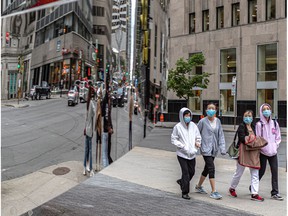There is encouraging news for downtown in the Montreal City Center Report, which measures the effect of the COVID-19 pandemic.

Article content
The vacancy rate for downtown Montreal office buildings was higher in the third quarter of 2021 than during the same period in 2020 and 2019, according to the latest edition of a quarterly report on the the socioeconomic panorama of the city center. 41% of shops and restaurants in office buildings or metro and train stations were permanently or temporarily closed.
Commercial
This ad has not been uploaded yet, but your article continues below.
Article content
But the fourth edition of the Montreal City Center Report, which has been measuring the effect of the COVID-19 crisis and highlighting efforts to revive the city, also contains encouraging news. Sales of new and existing condos in the city center have rebounded from a dramatic drop during the second quarter of 2020 and median prices are on the rise, with new condo construction at 65% and rental housing at a 53%.
The presence of CEGEP and university students in downtown Montreal now that they have returned to face-to-face classes is felt everywhere from restaurants to public transportation. And a trickle of tourists returned to Montreal during the summer of 2021. This meant that hotel occupancy in August 2021 was double that of August 2020, though only half of what it was in August 2019.
Commercial
This ad has not been uploaded yet, but your article continues below.
Article content
However, “restoring activity to pre-pandemic levels is still out of sight,” the report said. Despite the high vaccination rate and the advent of vaccination passports, the fourth wave of the pandemic has “prolonged the uncertainty” felt by Montréal residents and has caused “a complex and dynamic situation where hope and anxiety are intertwine “.
The first edition of the Montreal City Center Report, released by the Quebec Urban Development Institute and the Downtown Montreal Center-Ville Merchants Association in October 2020, was filled with gloomy news about the economic cost of the pandemic in the city center.
The latest edition, based on the results of an online survey conducted in early September among 1,000 residents of the Montreal metropolitan area, “speaks of some resumption of activity,” according to the introduction, “but there are still clouds on the horizon. . “
Commercial
This ad has not been uploaded yet, but your article continues below.
Article content
Downtown Montreal “retains its appeal, but the current trend is toward shorter leases and smaller offices,” the report says. Although companies generally opt for long-term leases to ensure predictability, brokers interviewed for the report said that 84 percent of the deals signed were for terms of between two and five years, an indication of “a degree of caution by part of the companies involved “.
About half of the leases involved companies moving from one downtown location to another; more than a third involve businesses relocating downtown from elsewhere, and new lease negotiations typically involve a reduction in square footage.
Seventy-seven percent of respondents reported that they were working remotely, either part-time or full-time, during the third quarter of 2021. When asked about workplace preferences after a pandemic, 71 percent said they would like to work from home “most of the time or at least half the time.”
Commercial
This ad has not been uploaded yet, but your article continues below.
Article content
The number of people who work remotely part of the time has increased slightly, but the number who work exclusively remotely has decreased: it fell below 50 percent during the third quarter for the first time since spring 2020.
However, despite the successful vaccination campaign and the implementation of the vaccine passport, people are not flocking to the stores in downtown Montreal, according to the report. The key element supporting growth is the volume of customer traffic and that depends on factors including the return of workers to offices and the long-term future of remote work, he said.
Although the number of store closures has decreased slightly, 34 percent of stores remain closed in shopping malls, where businesses rely on office worker traffic. Business has improved since late 2020 for ground-floor retailers in office buildings and near metro stations, but more than four of the 10 stores remain closed. On Ste-Catherine St., three percent of stores are temporarily closed and 17 percent of commercial spaces are empty, compared to 13 percent in 2019.
Commercial
This ad has not been uploaded yet, but your article continues below.
Article content
Between the first and third quarters of 2021, companies seeking a work model that combines remote and office work increased their roster of employees by 20 percent, according to the report, while companies that had not announced plans Similar saw their workforce cut in half.
Before the pandemic, most people used public transportation to get to the city center. The third quarter of 2021 ushered in a shift toward these pre-pandemic habits. Car use fell to 49 percent from 57 percent in the second quarter of 2020, according to the report. Public transportation, which accounted for 58 percent of all trips before the pandemic, is now used by 45 percent of those surveyed.
-
Report reveals economic cost of pandemic in downtown Montreal
-
Downtown Montreal Office, Retail Vacancies Continue to Rise
Reference-montrealgazette.com

